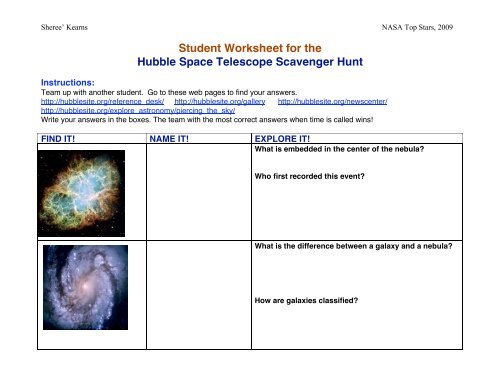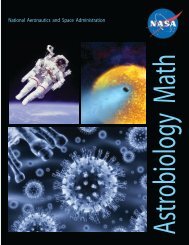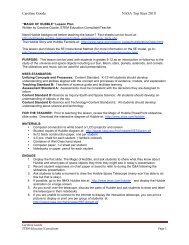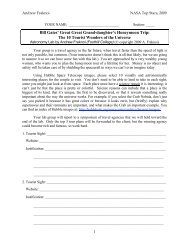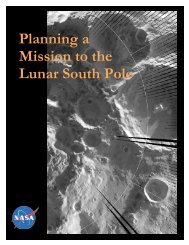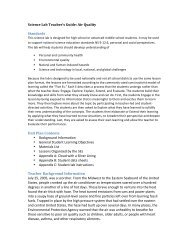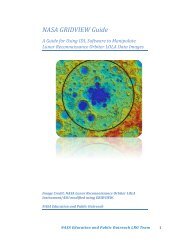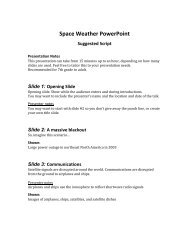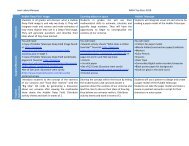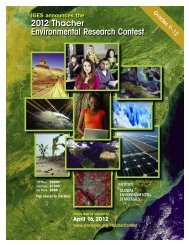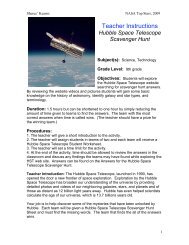Student HST Scavenger Hunt Worksheet-3 - Top Stars
Student HST Scavenger Hunt Worksheet-3 - Top Stars
Student HST Scavenger Hunt Worksheet-3 - Top Stars
Create successful ePaper yourself
Turn your PDF publications into a flip-book with our unique Google optimized e-Paper software.
Sheree’ Kearns NASA <strong>Top</strong> <strong>Stars</strong>, 2009<br />
<strong>Student</strong> <strong>Worksheet</strong> for the<br />
Hubble Space Telescope <strong>Scavenger</strong> <strong>Hunt</strong><br />
Instructions:<br />
Team up with another student. Go to these web pages to find your answers.<br />
http://hubblesite.org/reference_desk/ http://hubblesite.org/gallery http://hubblesite.org/newscenter/<br />
http://hubblesite.org/explore_astronomy/piercing_the_sky/<br />
Write your answers in the boxes. The team with the most correct answers when time is called wins!<br />
FIND IT! NAME IT! EXPLORE IT!<br />
What is embedded in the center of the nebula<br />
Who first recorded this event<br />
What is the difference between a galaxy and a nebula<br />
How are galaxies classified
Sheree’ Kearns NASA <strong>Top</strong> <strong>Stars</strong>, 2009<br />
FIND IT! NAME IT! EXPLORE IT!<br />
How is this type of galaxy different from a regular spiral<br />
galaxy<br />
Greek astronomers called a galaxy “galaxies kuklos”,<br />
which is also thought to be the same kind of galaxy<br />
pictured. What is the name of this galaxy<br />
What kind of galaxy is this<br />
Write a definition for this type of galaxy.<br />
What kind of galaxy is this<br />
Write a definition for this type of galaxy.
Sheree’ Kearns NASA <strong>Top</strong> <strong>Stars</strong>, 2009<br />
FIND IT! NAME IT! EXPLORE IT!<br />
What is happening to these two galaxies<br />
What are the two orange blobs in the picture<br />
In what galaxy are these stars located<br />
Approximately how old are these stars<br />
Give a definition of these kinds of stars.<br />
What is a Wolf-Rayet Star<br />
How is this star type different from white dwarf stars
Sheree’ Kearns NASA <strong>Top</strong> <strong>Stars</strong>, 2009<br />
FIND IT! NAME IT! EXPLORE IT!<br />
What did this scientist see in 1845<br />
This galaxy is now known by this name.<br />
How far away is this galaxy from the Milky Way galaxy<br />
In 1929 this scientist aimed the 100-inch telescope on<br />
Mt. Wilson in California at Great Spiral in the<br />
Andromeda Galaxy . What was this scientistʼs name<br />
This scientist actually found the existence of one of<br />
these.<br />
Take a journey<br />
to this<br />
http://hubblesite.or<br />
g/explore_astrono<br />
my/<br />
Take a journey to a black hole. When visiting a black<br />
hole, what force distorts the view seen by bending the<br />
light coming from distant stars<br />
Name the locations of the two black holes featured in<br />
this interactive video.
Sheree’ Kearns NASA <strong>Top</strong> <strong>Stars</strong>, 2009<br />
FIND IT! NAME IT! EXPLORE IT!<br />
This number expresses the<br />
rate at which the universe<br />
expands with time.<br />
In this news release, Riess used Hubble Space<br />
Telescope's crisp view along with 2003 data from<br />
NASA's Wilkinson Microwave Anisotropy Probe to refine<br />
the value of the universe's expansion rate to three<br />
percent. What does this new value imply about dark<br />
energy<br />
Term commonly used to<br />
describe how the universe<br />
began. Check this web<br />
page:<br />
http://hubblesite.org/newsc<br />
enter/archive/releases/2004<br />
/28/<br />
What percent of the way back in time has the Hubble<br />
looked to see glimpses of the beginning of the universe<br />
Define this term.<br />
When scientists used the <strong>HST</strong> to study Cygnus X-1, they<br />
were able to observe two of these events, which defines<br />
the tern defined above.


